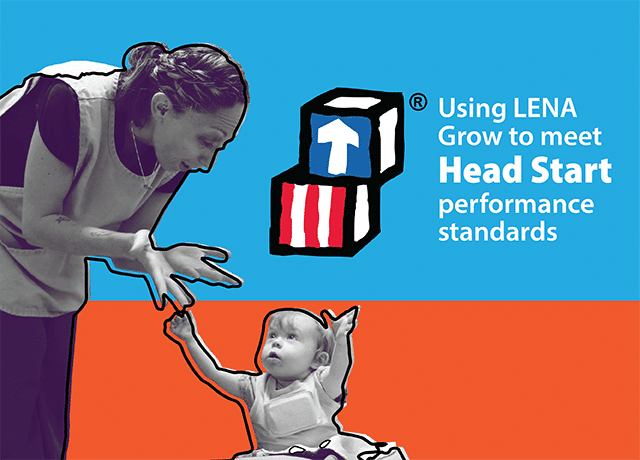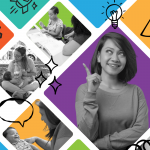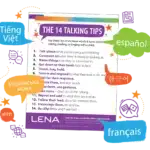[quote]
PACT, a LENA program partner since 2020, has grown to serve hundreds of children annually in more than two dozen Early Head Start/Head Start (EHS/HS) and EHS-Child Care Partnership classrooms across Oahu and Hawaii Island. Part of what makes their EHS/HS work “far from easy” is also what makes it so impactful: building child care programs that support children, families, and providers, all while meeting the strict rigors of the Head Start Program Performance Standards (HSPPS).
The HSPPS were first published in 1975, 10 years after the initial pilot of the Head Start program itself. These standards are detailed and explicit. They’re also critical for ensuring that all Head Start programs provide a high-quality care environment for our youngest learners.
To verify that programs are meeting these standards, PACT, like all EHS/HS grantees, undergoes a thorough federal review of their programs on an annual basis. During their most recent federal review, PACT’s team had an epiphany. The organization’s investment in LENA Grow, they realized, made it easy to show how they were meeting a variety of Head Start performance measures.
“The federal review team was impressed that LENA Grow was something we were doing for our teachers in the classroom,” said Jon-Vincent Jamir, PACT’s Head Start Area Manager and LENA Grow coach. “Being able to see the LENA data helped teachers reflect on their daily practices and think of ways to be more intentional in having engaging conversations with particular children.”
PACT first brought LENA Grow to its EHS/HS classrooms in late 2020. Since that time, around 100 children and two dozen teachers have participated. For the children, that means wearing the LENA “talk pedometer” once weekly and having their experiences of the language environment automatically analyzed. For teachers, it means weekly strengths-based coaching sessions, where they explore the data and set goals for how to increase interactions with particular children and at particular times of the day. Independent evaluations show that LENA Grow has a positive impact on children’s language and literacy skills, social development, emotional growth, and on teachers’ job satisfaction and self-efficacy.
[callout]
Beyond conversational turns data
Among the most important metrics for any LENA Grow program is evidence of increased numbers of serve-and-return interactions between teachers and children, or conversational turns. Research studies have linked conversational turns early in life to positive effects on brain structure, preliteracy skills, social skills, language development, and more.
When Jamir refers to PACT’s “LENA data,” conversational turns are a big part of what he means. And when it comes to increasing conversational turn rates, PACT’s classrooms have exceeded the national average. For instance, children who came into the program experiencing below-average levels of interaction have experienced a 75 percent increase in conversational turns.
Outside of the numbers, the story of LENA Grow’s impact on the Head Start educators was equally powerful.
“The 14 Talking Tips helped staff become more aware of how they communicate with children in their care and how often they were engaging the children in conversations,” Jamir said. “Being able to look at data with our teachers allowed them to see an hourly breakdown of the number of conversations they were having with the students. It helped them to see times of the day, the daily routines, in which they had lots of conversations and times in which they needed to support more conversations with the children.”
LENA Grow and EHS/HS Federal Review
During the 2022 federal review process, LENA Grow helped PACT demonstrate effectiveness in several specific performance measures, especially within the domains of “Monitoring and Implementing Quality Education and Child Development Services”:
- PM2.3. The grant recipient will demonstrate how teachers create nurturing and responsive learning environments for children, including ensuring environments promote critical thinking and problem solving, encourage children’s engagement, and are communication and language rich. 1302.31(b)(1)(i)
- PM2.4. The grant recipient will share and demonstrate how teachers support child-teacher interactions, socialization, development, and learning at all times, including during daily routines and mealtimes. 1302.31(e)
- PM3.1. The grant recipient will demonstrate how the program assists education staff in using data to individualize learning experiences to improve outcomes for all children. 1302.92(b)(5)
- PM3.3. The grant recipient will demonstrate how the program identifies strengths, areas of needed support, and which education staff would benefit from intensive coaching. 1302.92(c)(1)
Similarly, another LENA Grow partner, Sequatchie Valley Head Start, was also able to demonstrate effectiveness for measures such as PM3.3, by showing that classroom coaches were able to “use LENA Grow data when determining the coaching level for EHS staff and focus interventions on enhancing, promoting, and increasing language use and development.”
Head Start as a model program, with room to grow
When it comes to interactive language environments, EHS/HS programs are performing better than other child care settings. LENA’s recent analysis of nearly 15,000 daylong audio recordings in early childhood education settings revealed that children in Head Start classrooms experience higher average conversational turn rates than children in other child care settings.
For instance, infants aged 2-11 months in Early Head Start classrooms experience more conversational turns than infants in home settings. In other child care settings, on the other hand, infants experience approximately one-third fewer interactions than those in home settings. In addition, Head Start effectively negates the socioeconomic effect that researchers have observed in non-Head Start child care settings.
This means the Head Start Program Performance Standards and federal review processes work!
However, it’s important to remember that even highly interactive classrooms often still have children who experience very few conversational turns. Part of what makes LENA technology unique is its capacity to deliver insights into the experiences of individual children, not just the classroom as a whole.
Even in EHS/HS classrooms, for instance, language environments are still dramatically short of optimal, and approximately 13 percent of children have been found to experience language isolation. That means they have fewer than five conversational turns with their teachers for the vast majority of the day. Arrival time or lunch time may result in more turns for these children, but otherwise they experience almost no back-and-forth interaction with a teacher.
The importance of individual impact cannot be overstated.
In PACT’s case, there was one three-year-old child in a Head Start classroom who started the LENA Grow program experiencing only five conversational turns per hour. By the end of the program, they were consistently experiencing more than triple that number, including one day where they averaged 22 turns per hour!
That’s a testament to the dedication of that child’s teachers and to PACT’s coaches. And it’s an example of how clear, objective data, such as LENA Grow provides, gives teachers the information they need to truly individualize and support children, just as the HSPPS require.



